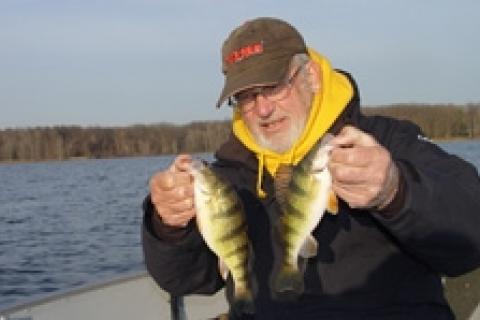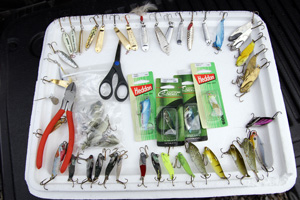
|
|
| Dave Lehman with a brace of jumbo perch taken on jigging spoons. |
The transition period that happens during fall, as the water cools and lakes turn-over, is a signal to savvy anglers that many species like walleyes, smallmouth bass, crappies and yellow perch will begin to gather up in defined areas. Though the water is cold, and the fish are somewhat lethargic, they are still catchable.
"Heavy metal" baits like blade baits and jigging spoons are often the best presentation to get them to bite. These lures are particularly effective in situations where gamefish are stacked in a relatively small area, concentrated there in response to baitfish location, or perhaps current conditions in the case of a river; they work because you can stick them right in the fish's face and tease them into a reaction strike.
For those unfamiliar, blade baits are compact metal vibrating lures, such as Bass Pro Shops' XPS Lazer Blade. Featuring a minnow-shaped stamped metal body that incorporates a lead weight in the nose, blade baits are typically fished in a vertical manner. Weight sizes in the quarter to three-quarter ounce range cover nearly all fall late fall angling situations.
The jigging spoon considered here is of the style of Bass Pro Shops' Strata Spoon, a hammered spoon available in a variety of sizes and color options. As with the blade bait, an assortment of spoons from quarter- to three-quarter ounce will cover the bases.
While blades and spoons can be had in various colors, I tend to stick to silver or chrome, a finish that shows plenty of flash, and also emulates a minnow or shad. During some days fish show a preference of one style bait over the other, so it pays to be prepared to fish both of them. On particularly slow days I like to tip a jigging spoon with a small fathead minnow, which can trigger extra bites, especially from walleyes. Tipping a blade bait is usually ineffective, as it throws off the balance of the lure.
Here's a look at two classic late fall angling scenarios where heavy metal baits shine. With a little modification you can adapt things to your late fall situations.
Deep Humps, Ledges on Lakes & Reservoirs
|
|
| An assortment of various sized blade baits and jigging spoons will prepare you for fall fishing. |
By the time water temperatures drop into the low 50s the deeper lakes and reservoirs will have turned over. Baitfish such as gizzard shad will be looking for the warmest water available, which is often in the deeper basins, which cool off more slowly. Gamefish like walleyes will follow this movement of forage species, often intercepting their prey from ambush points located along the edges of rocky humps and ledges. It's a tailor-made situation for fishing a blade or jigging spoon.
Consider a series of trips I made one fall/early winter to Pymatuning Lake, a 16,000-acre sprawling, flatland reservoir on the Pennsylvania/Ohio border. During the start of what turned out to be a mild winter, my partner Dave Lehman and I pulled in dozens of quality-sized yellow perch in the 10- to 12-inch range by fishing spoons and blades along the base of a large rocky hump. This hump is located in the deep end of the lake (where the warmest water was); while it tops out in the 3-foot range, we caught all of our fish in 18 to 20 feet of water, where the base of the hump blends into the main lake basin. As they were hovering a foot or two above the bottom, the perch were easy to see on the sonar screen. Once the perch were located it was a simple matter of positioning the boat directly above them and then putting a jigging spoon or blade bait right in front of them. Many times you'd see the fish move on the sonar screen as they captured the lure. While we caught a few fish on soft plastic jigs, the metal baits produced the most.
Slackwater Holes on Big Rivers
River systems provide some of our most consistent fall/winter fishing. The species could be walleyes, sauger, smallmouth bass or white bass. They all have one thing in common: When the water gets cold, they all move to the slackwater pools where they don't have to fight strong current.
Slackwater holes are often found within major river bends. Such pools can also be located below current defecting objects like islands and gravel bars. If debris such as leaf litter collects on the surface of a spot there's a good chance it will collect gamefish when the water is cold.
Fish a slackwater pool by yo-yoing a blade or spoon (see below for tips on working the bait) close to the bottom as the boat drifts slowly with the current. Boat control is a big factor in this presentation. The operator should use the trolling motor to make the necessary adjustments in boat position so that the lures are fished in a vertical position.
| Working Blades & Spoons
Fishing a blade bait is often referred to as "pumping a blade" due to the up-and-down motion used to work the lure. Every blade-bait angler develops his or her method in which they have confidence. I like to impart a rather aggressive upward swept, enough to give the lure a strong vibration. I limit the lift to a foot or two, so it's easier to control. Once the lift if complete, I allow the bait to fall on a fairly tight line. If the bait free-falls on a slack line, a hook often fouls around the line. Most hits occur on the drop; if you don't feed the bite (which is often simply a spongy feeling), the fish will typically be there when you start your next upward jig. I pause the bait for a couple seconds between jigs. In most instances you want your lure to be close to the bottom, so every so often let it make contact to be sure you're in the right spot. While a spoon is worked in a similar fashion, I tend to give it more of an upward twitch, rather than the snap used to get the blade to vibrate. Also, I give the spoon a much longer pause, as much as 10 seconds. I find fish more willing to hit a paused spoon that blade bait. Match the size lure you're using to the depth being fished and wind conditions. Depths in the 10 foot range often call for a quarter to three-eighth ounce lure. From 15 to 20 feet, a three-eighths to half-ounce lure is in order, while a three-quarter ounce bait is needed out to 30 to 35 feet. If it's windy figure on going to a heavier bait than what you'd normally use. A 6 to 6 1/2 foot medium-power, fast action spinning rod is ideal for working both blades and spoons. Braided line like PowerPro in 20 pound test lets you know what's going on down deep. Use a fluorocarbon leader (which is much stiffer than braid) of at least 14-pound test to keep minimize fouling. Always use a snap, otherwise the jigging action will saw through the knot. |
- 2406 views



